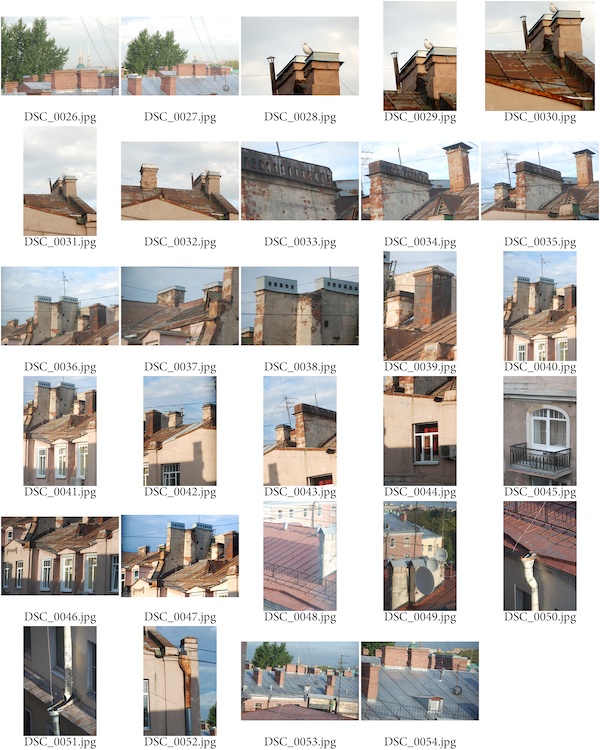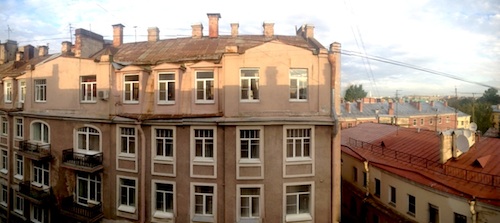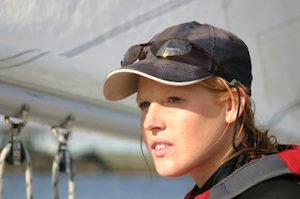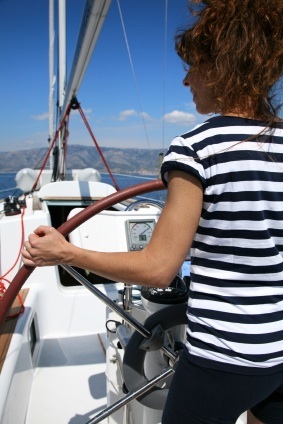A few years back I was asked to keynote the annual conference of British Columbia's teacher librarians. They had selected a theme that would revolve around "Fresh" - and embracing change in a positive proactive manner, so I chose "Catching that fresh breeze" as my title and used sailing as a metaphor throughout my presentation. I later published that speech as an article - "The Brave New Librarian" - which is available online. You can also download a movie of my PowerPoint presentation by clicking here.
Finding the Right Images
In order to stimulate the group's imagination, I wanted to start off with more than a dozen photos of people sailing. I would ask them to jot down words that came to mind - especially verbs - as they saw the images.
As soon as I started seeking good photos, I ran into a serious challenge. It was very hard to find photographs showing women at the helm of a sailboat. There were many thousands of images available for free use from Flickr (with attribution), but most of these showed men in charge. With an audience that would include a majority of women, I felt it essential to provide some gender balance, but this proved almost impossible with Flickr. Many of the members do not include key words or tags when they post their photographs, and even when they do, they may not include any gender references. A student going through this same challenge will have to test out words like "skipper" and "helm" and "woman." When I tried these strategies, they produced few results and the search was taking forever. I could find many images with "sailing" or "sailboat" as tags, but none of these hundreds showed me any women at the helm.
As I have pointed out in previous articles, we now suffer from something I call "the poverty of abundance." We have a mammoth supply of text, data and images, but locating quality is often wearisome. This would be a good time for the reader to stop and try this same challenge. How long will it take you to find a single great copyright free photograph of a woman at the helm of a sailboat?
After more than an hour of searching on Flickr, I turned to stock photos, knowing that companies like Corbis.com and istockphoto.com took pride in the key words and tags they attached to each image being offered for sale. While I did not want to spend much money, the time wasted on fruitless searching was exacting a different cost.
At istockphoto.com I tried "woman skipper" as a search strategy and instantaneously had five pages of women on boats.. Try it for yourself. Thirty-one per cent showed them actually touching the helm. By adding the word "helm" to the search box, the percentage climbed into the nineties. Many of these were a bit sexy and inappropriate for my audience, but there were quite a few that would serve me well, and the cost turned out to be quite reasonable. My search took me less than five minutes.
Why not turn to Google Images? Give it a try with "woman skipper helm." The search terms produce photos with men at the helm, women at the helm and many photos that seem unrelated. We are once again faced with the poverty of abundance, and Google's Advanced Search offers no help with images.
A few of the images found with Google's help are excellent like this one of Amer Sports Too skipper Lisa McDonald from the 2001-02 Volvo Ocean Race. While students may include such photos in school projects thanks to "fair use," the rules for use outside of school are much more stringent, and it is our job as educators to instruct them in copyright compliance. You will note that I link to the photo here but do not include it in my article.
The Web site showing the photo of Lisa McDonald states strong copyright restrictions at the bottom of the page.
- Photographs are copyright by law. If you wish to use or buy a photograph you must contact the photographer directly (there is a hyperlink in most cases to their website, or do a Google search.) with your request.
Please do not contact Sail-World.com as we cannot give permission for use of other photographer’s images.
In the case of Lisa McDonald's image, one must visit http://www.carloborlenghi.net/
to determine the cost and availability of the image from Carlo Borlenghi
in Milan.
While many adults and children may consider all images found on Google to be in the public domain, this is not the case.
There is widespread misunderstanding and disrespect for the rights of artists, whether they be writers, photographers, singers or painters as many bloggers feel free to beg, borrow or steal copyrighted work. Schools are expected to help students to understand the moral concepts involved in copyright as part of digital citizenship (ISTE).
Which is the Best?
The collecting of images should be guided by criteria the class has discussed in advance. While I will provide examples of criteria, the class might understand better if they help to develop the list. The teacher explains what criteria are. Then the teacher asks the class to suggest what makes a truly great image.
- A truly great image packs a punch. It makes a strong statement. It touches the heart. It makes the viewer feel strongly.
- A truly great image is artistically stunning. It will be clear, intense and well composed. It will have crisp colors and great focus. It will be louder than words.
- A truly great image is the right size for the work project. If there is little space, the image must speak loudly even if it is small. If there is plenty of space, the image must also speak loudly.
The list should be reasonably short and clear, written in words that make sense for the age level of the class. New vocabulary might be introduced to enrich the students' understanding of imagery. If the teacher conducts a Google search for "image selection criteria," many good Web sites are available like Woodburn Photography. That page lists 33 criteria organized by categories such as technical criteria, visual and aesthetic criteria, content, viewer's response, and general characteristics.
Giving Students Practice
Many readers will be able to think up searches like the skipper challenge I described earlier that are curriculum appropriate - that match the subject, the topics and the concepts being taught, but I thought a few more examples might prove valuable. Try some of these:
Elementary Examples
- You have been asked to create a poster to develop public support to protect an endangered species. Pick a species you care about from this web site provided by the U.S. Fish and Wildlife Service. After you have read enough about your species so you understand the threats facing this species, ask what kinds of images might make citizens care about its survival. Employ the sites and search strategies we have been practicing in class to find 2-3 striking images that will work well on your poster. Use the criteria we discussed to make your choices. Then create the poster employing the software and design strategies we discussed in class.
- You have been asked to create a poster to alert young children to some danger in the home like a hot stove.
- You have been asked to develop instructions to show young children the steps in completing a task like making a bed.
Middle School Examples
- You have been asked to create a poster to develop public support to improve some public service like the parks or the transportation in your town. Consider all the possibilities and then pick one that you would like to see improved. There is a list in Wikipedia under "sectors" to help you think about possibilities. After you have chosen your public service, define how it needs to be improved and then ask what kinds of images might make citizens care about its improvement. Employ the sites and search strategies we have been practicing in class to find 2-3 striking images that will work well on your poster. Use the criteria we discussed to make your choices. Then create the poster employing the software and design strategies we discussed in class.
- You have been asked to develop instructions to show seniors the steps in completing a task like making a hotel reservation using the Internet and a site like Booking.com.
High School Examples
- You have been asked to create a poster inviting the public to a public meeting about some important political issue in your state. Identify an issue such as gun control that you think your state's laws do not address sufficiently at this time. Do enough research on this issue so that you can take a strong stand and suggest specific changes to existing legislation. Perhaps you think gun control should be strengthened? Perhaps you feel the laws are already too strong. Define your position and then employ the sites and search strategies we have been practicing in class to find 2-3 striking images that will work well on your poster. Use the criteria we discussed to make your choices. Then create the poster employing the software and design strategies we discussed in class.
- You have been asked to develop instructions to show high school students how to perform a complicated task like editing video using a software program such as iMovie.
Challenging Students to Create Their Own Powerful Images
When students wrestle with the task of producing great photographs and videos, they have a chance to apply the criteria mentioned above to their own artistic efforts. To illustrate this process, I shot 29 photos of the building across from the apartment I was renting in St. Petersburg while writing this article. These photos are shown below on a contact sheet nicely provided by an automated program included with Photoshop.

While I did not have a teacher assigning me a project like those mentioned above, I did have in mind sharing some of the beauty I saw across the way that was quite different from buildings back home. I was struck by the shapes and the colors, and I knew one or two very special photographs would emerge if I made use of my high powered zoom lens and Nikon D80 SLR camera.
I began the process using the camera on my iPhone and an app called "360" to capture the scene before me as a panorama.

I then started to zoom in with the Nikon to capture aspects of this scene that seemed intriguing, colorful and visually enticing in some way. The process was akin to dissection. It was almost like deconstruction — breaking the scene down into its components. Unlike some of the very structured projects mentioned earlier in this article, I was exploring and discovering. My purpose was not entirely clear to me at the outset and the process was a combination of trial and error along with some purposeful visual wandering. The contact sheet shows the sequence I followed as I focussed in on sections that captured my fancy. The seagull perched on a chimney top drew my attention immediately, but then I moved on to sections of the roof that combined interesting rust colors with intriguing angles and shapes. Toward the end I captured some interesting pipes and gutters.
Since I intended to share something special about St. Petersburg with folks on my Flickr account who may never get a chance to visit the city, I loaded the photos onto my laptop where I could see them enlarged with iPhoto and I began asking myself which images contained the most magic. Which had the best composition? Which offered the most stunning colors? I finally settled on these two . . .

Someone else might choose differently, but these two struck my fancy more than any of the others. If you would like to browse these images full size, you may click on any of them in the contact sheet below.

Teachers may engage their students in similar projects so they have an opportunity to produce and select powerful images to support the arguments they are making. Persuasion in this decade demands skillful creation and selection of such powerful images.
|






